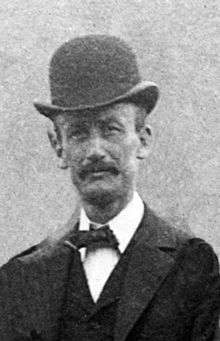Henry Barnard Kümmel
| Henry Barnard Kümmel | |
|---|---|
 Kümmel in 1897 | |
| Born |
May 25, 1867 Milwaukee, Wisconsin |
| Died |
October 23, 1945 Trenton, New Jersey |
| Nationality | United States |
| Fields | geology |
| Institutions | Geological Survey of New Jersey, New Jersey Department of Conservation and Development |
| Alma mater | Beloit College, Harvard University, University of Chicago |
| Notable awards | Fellow, Geological Society of America |
Dr. Henry Barnard Kümmel (1867 - October 23, 1945) was a State Geologist for the State of New Jersey during the 20th century who worked extensively in the management of the Morris Canal after its acquisition by New Jersey.[1][2]
Biography
Kümmel was born in 1867 in Milwaukee, Wisconsin. His wife was Charlotte C. Kümmel.[3]
Kümmel was an elder at Prospect Street Church and sat on the judicial commission for the trial of Rev. Dr. J. Gresham Machen in 1935, but resigned his post before the conclusion of the trial.
Two quit board in Machen trial; Successors chosen after one of those named is said to sympathize with pastor.[4]
Kümmel died 23 October 1945 at home in Trenton, New Jersey, following a lengthy illness.
Career
On May 12, 1908, Kümmel became the founding Chairman of the Association of American State Geologists (AASG) in Washington, DC.
In the 1930s, Kümmel compiled the "Henry B. Kümmel Collection" of photographs maintained by the New Jersey State Archives, including many historically significant images of the Morris Canal.[5]
Kümmel's work on the Morris Canal also led the way for the preservation of the Pequannoc Spillway and Pompton Dam in Pequannock, NJ through his proclamation that to remove them would reduce the surrounding area to a series of "ill smelling mud flats," a statement quoted by consulting engineer Cornelius Clarkson Vermeule II upon his decision to preserve the structures.[6]
As New Jersey State Geologist, Kümmel contributed to a large number of reports of great historic significance to the State of New Jersey, including the annual report for 1910, reports on the decommissioning of the Morris Canal, and a report describing glacial drift cited extensively by the New York Times.[7][8]
Kümmel also served as Director of the Department of Conservation and Development, where on May 19, 1932 he presided over the acceptance of 2,500 plants for the George Washington Memorial Arboretum at Washington Crossing State Park from Charles Lathrop Pack and son, Arthur Newton Pack.[9]
References
- ↑ Kümmel, H.B. "Bulletin 1. Annual Administrative Report of the State Geologist" (PDF). New Jersey Geological Survey. Retrieved 20 February 2013.
- ↑ "Dr. Kummel Dead; Jersey Geologist; Retired Head of Conservation Department Was 78 – Served the State for 45 Years". New York Times. Retrieved 24 October 1945. Check date values in:
|access-date=(help) - ↑ "Mrs. Henry B. Kümmel". New York Times. Retrieved 20 February 2013.
- ↑ "Two quit board in Machen trial; Successors chosen after one of those named is said to sympathize with pastor". New York Times. Retrieved 23 January 1935. Check date values in:
|access-date=(help) - ↑ "Henry B. Kümmel Collection". New Jersey State Archives. Retrieved 20 February 2013.
- ↑ Vermeule, C.C. (29 June 1929). "Final Report of Consulting and Directing Engineer". Hathi Trust Digital Library.
- ↑ "Geological Survey of New Jersey; Report of Henry B. Kummel, State Geologist, Nearly Ready for Distribution – Glacial Drift Described". New York Times. 18 January 1903.
- ↑ Rollin D. Salisbury, assisted by Henry B. Kümmel, Chas. E. Peet, George N. Knapp (18 January 1903). "The Glacial Geology of New Jersey". Geological Survey of New Jersey.
- ↑ "New Jersey accepts gift of arboretum; 1,000 trees and 1,500 Shrubs in Washington Park Crossing – Governor at ceremony". New York Times. 20 May 1932.